Plot
At the end of The War God’s Own, Bahzell had accepted the surrender of the much larger force commanded by the Sothoii Baron Tellian. Bahzell, Brandark and Kaeritha are now visiting the Baron's castle from which the baron rules a large portion of the Sothoii Empire. The surrender by Baron Tellian has caused political unrest within the Sothoii nation as does the presence of Bahzell and his entourage of Hradani, members of most recent chapter of the War God's monks.
Bahzell and his fellow Hradani run to the aid of the remnant of a herd of Coursers who were attacked by minions of one of the evil gods. For centuries these phenomenal, sentient horses have been revered by the Sothoii. They sometimes form lifelong mental links with a few select Sothoii warriors who are then known as "Windriders". Bahzell is the first non-Sothoii to become a windrider and rides a Courser who, like Bahzell, has become a champion of the war god. This, along with the obvious effort and sacrifice the Hradani have made to save the Coursers does much to alleviate the political tensions.
Meanwhile, Kaeritha, another war god champion, obeys her call to the Sothoii Warmaids, who are keen that there is no diminution of their legal rights. The devotees of the vile gods continue - as a third strand of their long-planned attack on the Sothoii - to manipulate and attack in Baron Tellian’s own lands.

Corum Jhaelen Irsei is the name of a fictional fantasy hero in a series of two trilogies written by author Michael Moorcock. The character was introduced in the novel The Knight of Swords, published in 1971. This was followed by two other books published during the same year, The Queen of Swords and The King of Swords. The three novels are collectively known as the "Corum Chronicles trilogy". The character then starred in another trilogy of books. the "Silver Hand trilogy", and has appeared in other stories taking place in Moorcock's multiverse.

Freyr, sometimes anglicized as Frey, is a widely attested god in Norse mythology, associated with sacral kingship, virility, peace and prosperity, with sunshine and fair weather, and with good harvest. Freyr, sometimes referred to as Yngvi-Freyr, was especially associated with Sweden and seen as an ancestor of the Swedish royal house. According to Adam of Bremen, Freyr was associated with peace and pleasure, and was represented with a phallic statue in the Temple at Uppsala. According to Snorri Sturluson, Freyr was "the most renowned of the æsir", and was venerated for good harvest and peace.

In Norse mythology, Sleipnir is an eight-legged horse ridden by Odin. Sleipnir is attested in the Poetic Edda, compiled in the 13th century from earlier traditional sources, and the Prose Edda, written in the 13th century by Snorri Sturluson. In both sources, Sleipnir is Odin's steed, is the child of Loki and Svaðilfari, is described as the best of all horses, and is sometimes ridden to the location of Hel. The Prose Edda contains extended information regarding the circumstances of Sleipnir's birth, and details that he is grey in color.

The Four Horsemen of the Apocalypse are figures in Christian religion, appearing in the New Testament's final book, Revelation, an apocalypse written by John of Patmos, as well as in the Old Testament's prophetic Book of Zechariah, and in the Book of Ezekiel, where they are named as punishments from God.

Diomedes or Diomede is a hero in Greek mythology, known for his participation in the Trojan War.

In Norse mythology, Svaðilfari is a stallion that fathered the eight-legged horse Sleipnir with Loki. Svaðilfari was owned by the disguised and unnamed hrimthurs who built the walls of Asgard.
The Chronicles of Thomas Covenant is a series of ten high fantasy novels written by American author Stephen R. Donaldson. The series began as a trilogy, entitled The Chronicles of Thomas Covenant, the Unbeliever. This was followed by another trilogy, The Second Chronicles of Thomas Covenant, and finally a tetralogy, The Last Chronicles of Thomas Covenant.
In C. S. Lewis's Chronicles of Narnia series of novels, Calormen is a large country to the southeast of Narnia. Lewis probably derived its name from the Latin calor, meaning "heat". When using the name as an adjective or an ethnonym, Lewis spelled the name with an 'e' at the end: a Calormene soldier; "The Calormenes have dark faces and long beards."
The Norse mythology, preserved in such ancient Icelandic texts as the Poetic Edda, the Prose Edda, and other lays and sagas, was little known outside Scandinavia until the 19th century. With the widespread publication of Norse myths and legends at this time, references to the Norse gods and heroes spread into European literary culture, especially in Scandinavia, Germany, and Britain. In the later 20th century, references to Norse mythology became common in science fiction and fantasy literature, role-playing games, and eventually other cultural products such as Japanese animation.
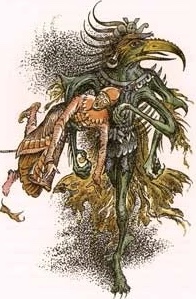
Tash is a fictional deity and demonic god, found in C. S. Lewis's Chronicles of Narnia series. He is an antagonist in the novels The Horse and His Boy and The Last Battle.

Ares is a fictional character, a deity appearing in American comic books published by Marvel Comics. The character is based on the Greek god of the same name. He first appeared in Thor #129 and was created by Stan Lee and Jack Kirby. Ares has commonly appeared as an enemy of Thor and Hercules and starred in his own self-titled series in 2006. In 2012, Ares was ranked 39th in IGN's list of "The Top 50 Avengers".

Hercules is a fictional superhero appearing in American comic books published by Marvel Comics.
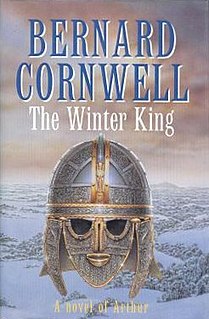
The Winter King: A Novel of Arthur is the first novel of the Warlord Chronicles trilogy by Bernard Cornwell, originally published in the UK in 1995 by Penguin Group. The book is based on characters and plot elements from Arthurian myth, but considerably changed and re-worked.
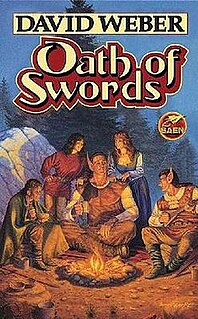
Oath of Swords is a fantasy novel by American author David Weber, the first in the War God. It follows the adventures of Bahzell Bahnakson and his friend Brandark; the format is a swords-and-sorcery land with dwarves, elves, humans, and hradani—the Four Races. There is a pantheon of gods, some good—the Gods of Light—and some vile—the Dark Gods.
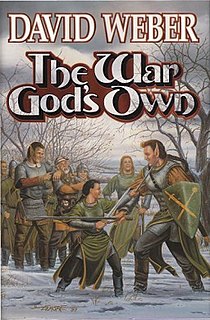
The War God's Own is a fantasy novel by American writer David Weber, published in 1999. The second book in his War God series, it follows the adventures of Bahzell Bahnakson and his friend Brandark. The novel is set in a swords and sorcery land with dwarves, elves, humans, hradani, and halflings—the Five Races of Man. There is a pantheon of Gods, some good and some vile. It is followed by Wind Rider's Oath, published in 2004.
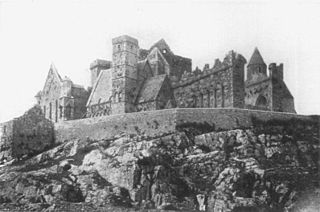
The Sack of Cashel, also known as the massacre of Cashel, was a notorious atrocity which occurred in the Irish County of Tipperary on 15 September 1647, during the Irish Confederate Wars, part of the Wars of the Three Kingdoms. The town of Cashel was held by the Irish Catholic Confederate's Munster army and was besieged and taken by an English Protestant Parliamentarian army under Murrough O'Brien the Baron of Inchiquin. The attack and subsequent sack of Cashel was one of the more brutal incidents of the wars of the 1640s in Ireland.

God of War: Ascension is a 2013 action-adventure game developed by Santa Monica Studio and published by Sony Computer Entertainment (SCE). The game was first released on March 12, 2013, for the PlayStation 3 (PS3) console. It is the seventh installment in the God of War series and a prequel to the entire series. Loosely based on Greek mythology, the game is set in ancient Greece with vengeance as its central motif. The player controls the protagonist, Kratos, the former servant of the God of War Ares, who tricked Kratos into killing his wife and daughter. In response to this tragedy, Kratos renounced Ares, breaking his blood oath to the god. Kratos was, therefore, imprisoned and tortured by the three Furies, guardians of honor and enforcers of punishment. Helped by the oath keeper, Orkos, Kratos escapes his imprisonment and confronts the Furies, aiming to free himself of his bond to Ares.

Conan and the Gods of the Mountain is a fantasy novel by American writer Roland Green, featuring Robert E. Howard's sword and sorcery hero Conan the Barbarian. It was first published in paperback by Tor Books in May 1993 and reprinted in November 1998.
Theros is a Magic: The Gathering block, consisting of the expansion sets Theros, Born of the Gods and Journey into Nyx. The block is a "top-down" design inspired by Greek mythology.















